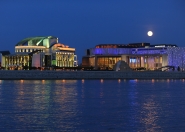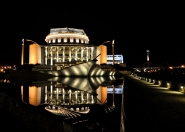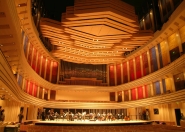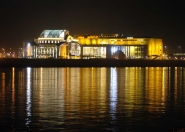
National Theatre
Budapest, IX. ker. Bajor Gizi park 1.
Telefon: 476 6868
The new National Theatre along the Danube first opened its doors on 15 March 2002. By the time of its completion, it became a national symbol.
Its charter states that “...in line with tradition, it will endeavour to honour the exponents of Hungarian and universal dramatic literature in the newly-constructed National Theatre, in a fashion befitting the significance of the institution.”
Budapest Operetta Theatre
I., Nagymez? utca 17. (+36-1 472-2030, www.operettszinhaz.hu)
The building that currently accommodates the Operetta Theatre was built in 1894 on the plans of renowned Vienna-based architects Fellner and Helmer. With up to 500 shows and 500,000 visitors a year, the Operetta Theatre is one of the most popular locations of cultural and society life in Budapest. Over the last few years, it has been transformed into a music theatre of European dimensions, where traditional values are represented by the operetta, while musicals ensure a modern touch.
Margaret Island and Városmajor Open-Air Stages
XII., Városmajor (+36-1 375-5922, www.szabadter.hu)
XIII., Margitsziget (+36-1 340-4196, www.szabadter.hu)
These well-established open-air stages, both located in popular parks on Margaret Island and in the Városmajor, respectively, are among the most sought-after concert venues on a summer night. The programme of Budapest Summer Festival organised on these stages, includes dance shows, musicals and other music performances.
Budai Vigadó—The House of Traditions
I., Corvin tér 8. (+36-1 201-3766, www.hagyomanyokhaza.hu)
The House of Traditions is a national institution established to preserve and to protect the folklore tradition of the Carpathian Basin. The shows of its ensemble, the Hungarian State Folk Ensemble give the audience the opportunity to get acquainted with all music genres related to tradition, ranging from historical music and authentic folk music and folk dance to world music based on traditional elements and spectacle theatre.
Danube Palace
V. Zrínyi u. 5. (+36-1 235-5500, www.dunapalota.hu)
The neo-Baroque palace located in downtown Budapest serves as a venue for high-quality performances of classical music and dance theatre shows as well as a home for the Danube Folk Ensemble, which is made up of a troupe of 24 dancers and a folk band with 5 members, and for the Danube Symphony Orchestra.
Millenáris
II., Löv?ház u. 39. (+36-1 438-5312, www.millenaris.hu)
This internationally well-known major factory unit of Hungarian industrial history now turned into one of the most popular cultural centres was first developed on the basis of the ironworks
founded by Ábrahám Ganz on the territory of the Pest Rolling Mill. The Theatrum and the Reception Building (two locations situated within the complex) often serve as venues for music
and dance shows covering a great variety of genres.
Palace Of Arts National Concert Hall
IX., Komor Marcell u. 1. (+36-1 555-3005, www.mupa.hu)
The Palace of Arts has everything needed to make a building a stronghold of culture. Imposing rooms, state-of-the-art technology and, first and foremost, the unique complexity that includes a wide range of genres performed at the same venue. Traditional, experimental and classical music, opera, dance, jazz, world music and fine arts can here be present together, in a productive interaction. The house is open both to international stars and up-and-coming talents.
Budapest Opera House
Budapest Opera House ( Andrássy út 22.) awaits you with rich musical programmes throughout the year in. The architecture of the building in itself worth a visit. Even if you aren't an opera fan a visit to the Hungarian State Opera House is a must.
Visiting Budapest Opera House, if you don't have time to attend a performance:
Tours in English, German, French, Spanish, Italian or Hungarian (you can request Dutch, Serbian and Croatian language tour) start every day at 15.00 and 16.00 all the year round. Tours start at the right-hand entrance at Hajós út.
I., Színház u 1-3. (+36 1-457-0848, +36-1 201-4407, +36-1 375-864, www.dancetheatre.hu)
National Dance Theatre, located in the impressive Castle District in Buda, awaits dance lovers with a historical atmosphere, an ambience radiating intimacy as well as a diversified programme. It offers the whole range of performances by Hungarian dance artists from folklore to classical ballet, from contemporary dance theatre to break dancing and from large ensembles to groups with a handful of artists.
Trafó House of Contemporary Arts
IX, Liliom u. 41. (+36-1 215-1600, www.trafo.hu)
The arts centres and cultural institutions moving into abandoned industrial facilities boast a tradition of a few decades in Western Europe. In Hungary Trafó was the first such place where life was about dance, theatre, art, literature and music.
Liszt Academy
Music VI., Liszt Ferenc tér 8. (336-1 342-0179, www.lfze.hu)
The Liszt Ferenc College of Music is not only a tertiary institute for the education of musicians and artists, but is also the centre of the capital’s concert life. Its Art Nouveau building, which can be seen today, was finished in 1907, and its interior is the most richly decorated example of this style in Budapest.











